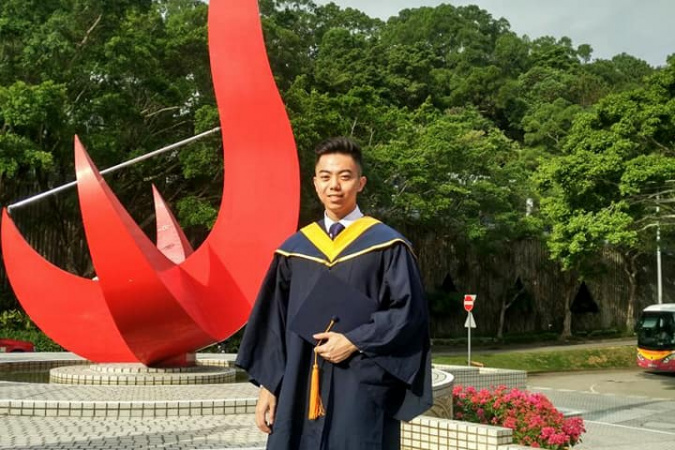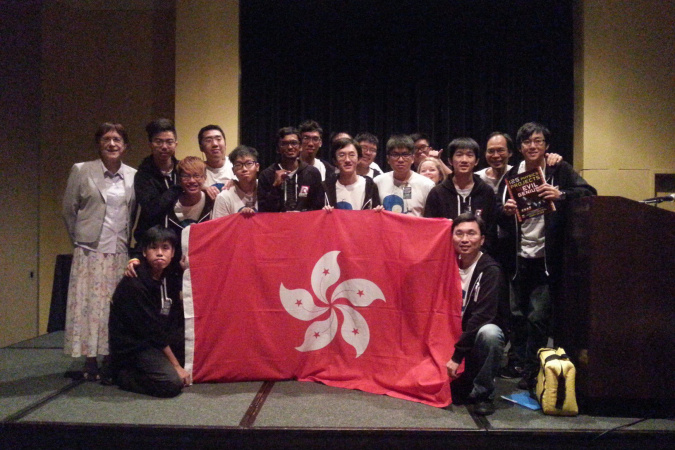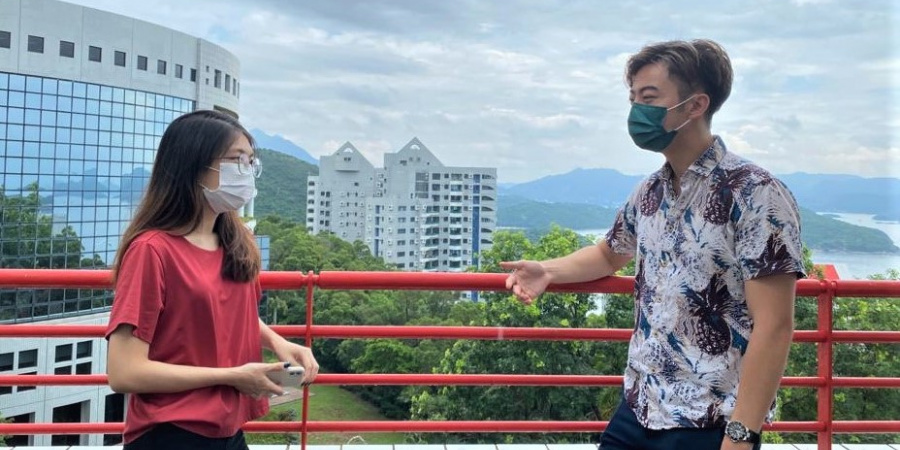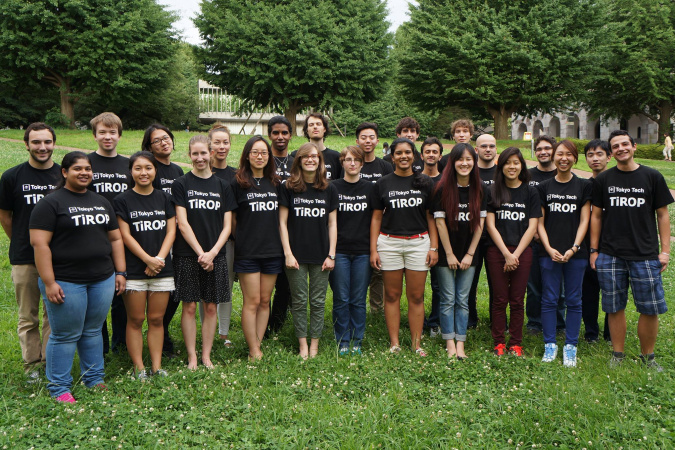“Uncertainty Is What Makes Life So Interesting!”
In 2012, alumnus Ne Myo HAN left his hometown Indonesia and came to HKUST, where he obtained his BEng and MPhil in Mechanical Engineering in 2015 and 2017 respectively. While studying at HKUST, he was an all-rounder who actively participated in various extra-curricular and academic activities. Under Prof. Jang Kyo KIM’s guidance, he studied graphene aerogels and co-authored six articles in peer-reviewed journals, accumulating over 300 citations so far. After completing his degrees at HKUST, Han worked as a materials engineer in a leading semiconductor company for four years.
Having gained research experience in graphene 3D structures and work experience in the industry, he recently received a prestigious Croucher Scholarship to pursue a PhD in Mechanical Engineering at the Massachusetts Institute of Technology (MIT) – a lifelong dream of his. Before he leaves for the US this summer, I was glad to be able to have a conversation with him on his journey in HKUST, career in the industry, dream of attending PhD studies, and more.
1. Starting off with the beginning of your journey at HKUST, how were you attracted to mechanical engineering, specifically in materials?
When I was planning for university, I initially wanted to study either mathematics or physics. Yet I ended up taking interest in mechanical engineering, which is a good integration between the two. When it comes to engineering, what fascinates me is how humanity keeps trying to achieve something that has never been achieved before – though problems arise in the process, we try to fix them, learn from them, and aspire to do better.
In the end, what really piqued my interest is materials, a field closely tied to everything else. During my time in HKUST Robotics Team, we wanted our robot to be rigid enough, so we made it so big that it ended up weighing 40 kilograms! This is because when you want to make something stiffer, you either increase its thickness or use materials with better properties. That was how I got inspired to discover stiffer and stronger materials, and conducted research on carbon-fiber-reinforced polymer in a summer research program at the Tokyo Institute of Technology in 2014.
Upon returning to HKUST from Japan, I stumbled upon Prof. Kim’s research on graphene aerogels, a three-dimensional material, which was exactly what I was looking for, since it could address the weak out-of-plane properties of carbon-fiber-reinforced polymer. I then decided to take part in his Undergraduate Research Opportunities Program (UROP) project, and later pursued my MPhil degree under his supervision as well.
2. Looking back on when you were a student, how would you describe your journey in HKUST Engineering? What were some memorable experiences?
The first word about HKUST that comes into mind is “opportunities”. I recall being overwhelmed by so many emails every day about all the happenings around, whether it is from my Department (Mechanical and Aerospace Engineering), the School of Engineering, or at university level, bringing us up to date with the abundant opportunities here. I joined the Robotics Team and the Engineering Student Ambassador (ESA) Program in my first year, and later became part of the Hall Education Team as well.
We, students, are full of potentials. But we need a spark to ignite the flame, and this is how HKUST helps – apart from academic studies, we are encouraged to have a holistic experience at the university, such as mentorship programs, competitions, research opportunities, exchange programs, summer internships, and many more.
One of the highlights of my HKUST journey was being an ESA, through which I learned a lot about teamwork, empathy, and how to connect with people better. I also gained more exposure to develop and polish my soft skills. There was even once a time where they organized a dining etiquette workshop for ESAs! In a way, being an ESA really gives you the freedom of thought and encourages you to know what you want, because you are the leader there. What will you do, given all these opportunities? Being able to put these forward and inspire other people gives me a sense of accomplishment, and I am grateful to be able to grow in this supportive family.
3. Could you tell us more about what you have gone through to achieve your dream of studying a PhD in MIT?
It was my high school dream to study for a PhD, so I am surely excited about this! In the past few years, I have been comfortable working in the industry, but then I began looking for another challenge. That was the time when, with the help of one of my course instructors at HKUST, Prof. Stephen LEE, I revisited my dream of pursuing a PhD degree in the States.
In fact, I only became closer with Prof. Lee during my final year in MPhil. He has been a great mentor and friend who encourages and supports me through my difficult times, including the time when my first PhD applications in the US were all rejected, right after completing my MPhil degree. In the end, he was the one who pushed and motivated me to step out of my comfort zone, and reapply for PhD studies after working here in Hong Kong for four years.
The actual process of choosing which universities and research groups to apply to could be very daunting at the start, but also very rewarding for someone serious about research. This time around, having built my portfolio with relevant publications and experience in the industry, I was more confident in my application. All these paid off in the end, and I got admitted to MIT!
4. Getting ready for your new journey in MIT, what is the spirit from HKUST you would like to carry on?
Having been exposed to the innovative environment in HKUST, I learned that when you have an idea or a goal, you have ways to find the right resources and the right people to help you realize your dream. It is about how you set your mind on your goal and how much work you put into it. I will definitely take this can-do spirit of HKUST to my future journey in MIT.
5. Could you recommend to us your favorite movie?
Inception is my favorite movie, but another movie that may have more relevance to my situation is Good Will Hunting. It is about humble beginnings, and I can relate to that because coming from Indonesia, we had to overcome hurdles after hurdles to study at HKUST. I remember having to study much harder than other students to attain the required grades for admission. Upon arriving in Hong Kong, there were still lots of adjustments we had to go through in the new environment. Despite the up and downs, I am proud of myself for making the decision to come to this place and doing well here, and I hope I can keep this up in my journey at MIT.
6. If you could meet your younger self, what would you like to tell him?
I would tell myself to stop worrying. I used to worry a lot as my younger self, especially my grades, when I started university. I thought: if I have too many things on my plate, will I be able to keep up with academics? Even when communicating with others, I could recite and rehearse what I plan to say over and over in my head, that I end up forgetting to say it.
In almost all scenarios, just keep worrying and doing nothing is the worst course of action one can take, as it consumes both your time and energy. One thing that Prof. Stephen Lee told me was, “if worrying can solve the problem, then go ahead and worry as much as you can.”
And so, I have learned not to worry too much – as it just creates another problem on top of the one you already have – and start doing something to solve my problem. This is applicable to not only studies and work, but also handling relationships with people. Since coming to the realization, my university life has been about seizing the opportunities offered by HKUST.
7. What advice would you give to your juniors who are stepping into their future?
It is all right if you still don’t know what you want to do, but do make an effort to explore your options. There are so many opportunities at HKUST: internships, UROP or summer research, student teams, or even building your own start-up. From there, go with what works the best for you, but keep in mind that it’s not permanent – choosing one does not mean you are tied to it for your entire career.
If you aspire to pursue further studies, I will tell you that there is no fail-safe formula for it. You will never know what is going to happen with your applications for graduate studies, but do your best and present your package – build your portfolio and include some research experience and publications to back it up. One more important thing is to maintain a good relationship with your teachers and supervisors.
There is no formula for success – everyone has a unique path to unfold on their own. It is great to be inspired by someone else, but I wouldn’t want anybody to follow in someone else’s footsteps all the way. Sometimes you see other people’s achievements, but you might not see the struggles underneath. So, don’t just follow a fixed path – having a little bit of uncertainty in life is what makes it so interesting!
By Engineering Student Ambassador Cindy Aiko Filbert Tanaka
Related link:
- MAE news (July 19, 2021): MAE alumni Ne Myo Han and Eunyoung Kim admitted to PhD programs at MIT and Stanford




